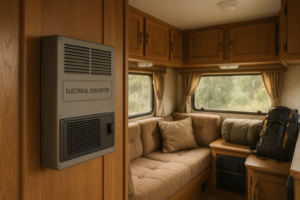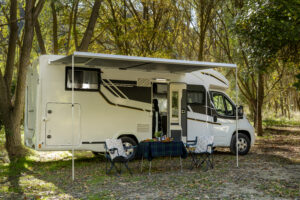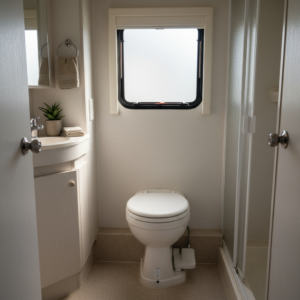RV Water Heater Maintenance and Repair Tips: Fix Common Problems Like a Pro
Table of Contents
Nothing kills campfire joy faster than an ice-cold shower after a dusty hike. If you’re frantically googling “RV water heater problems” at midnight, don’t worry – this guide will help you fix the problem quickly.
This guide walks you through essential RV water heater maintenance, quick on-the-road fixes, and the moments when calling a technician—or scheduling RV water heater repair service—is your smartest move. By the end, you’ll understand how your heater works, keep the right spare parts on hand, and feel confident knowing you’ll always have hot water when you need it.
Understand Your RV Water-Heater Type
Before you grab a wrench, confirm what kind of water heater your RV actually has. A quick peek behind the water heater door will reveal one of four common designs, each with its own maintenance routine.
Propane Tank Heater
Propane tank heaters are among the most common in RVs. To identify one, look behind the water heater door for:
- A fist-sized gas valve connected to a propane line
- A burner tube with an igniter and flame sensor
- A flue and chimney assembly where the burner fires and exhaust exits
These heaters rely solely on propane for heat, so your first maintenance checks should focus on burner cleanliness, flame strength, and proper gas pressure.
Electric Tank Heater
These systems are found in RVs with a dedicated 120-volt hookup. Visual clues include:
- No gas line present
- A single 120-volt element wire
- An exterior on/off rocker switch
In this setup, troubleshooting typically focuses on the heating element or campground voltage rather than the flame quality.
Dual-Fuel or Hybrid Tank Heater
This type gives you both gas and electric options. Visual clues to identify this heater include:
- A gas line and an element wire
- Two rocker switches – typically one for gas and one for electric, though colors and configurations can vary by brand or RV manufacturer
Because you have two independent heat sources, knowing which side has failed helps you target the problem and save time and spare parts.
Tankless (On-Demand) Water Heater
These are becoming more common in newer RVs. Visual clues that point to a tankless unit include:
- A deeper box rather than a shallow tank-style layout
- A round or square exhaust vent (design varies by brand)
- A large control board and wiring cluster
- A copper heat exchanger positioned toward the rear of the unit
Inside the coach, a digital temperature controller is usually present
These systems rely on water flow and quality, so lime scale buildup and low pressure are often the root of heating issues.
Locking in your water heater type now ensures every maintenance tip and repair step ahead is relevant to your RV.
Routine RV Water Heater Maintenance
A half-hour a few times a year can prevent most breakdowns and help you catch small issues before they ruin your trip.
Monthly
- Inspect for Leaks: Check all visible water connections, valves, and tank seams for drips, moisture, or signs of water damage. Early signs of trouble often hide in plain sight.
- Test Pressure–Temperature Relief Valve: Flip the lever for two seconds. A healthy valve gushes water. If it just dribbles or sticks, or if it doesn’t seal tight when closed, it’s time for a replacement.
Seasonally
- Flush Sediment from the Tank:
Shut off fuel and power. Remove the drain plug or anode rod, then flush the tank with a rinse wand until the water runs clear. A 50/50 solution of white vinegar and water is commonly used to break down stubborn scale. However, always consult your water heater’s operating manual before descaling – some models require citric acid instead of acetic acid, while others may call for proprietary decalcification tablets to avoid damaging internal components. - Inspect and Replace the Anode Rod:
If more than 75% of the magnesium rod is corroded, drop in a new one. It’s cheap insurance against tank rust and long-term damage.
Annually
- Inspect Propane Lines and Burners: Spray soapy water on the gas line connections and look for bubbles. Clean burner tubes and the orifice with a brush and compressed air to maintain a strong, steady flame.
- Clean Air Intake and Exhaust Vents: Remove debris from vent openings. This helps prevent carbon monoxide buildup and keeps your heater running safely and efficiently.
- Check Electrical Connections: Gently wiggle each quick-connect and crimp terminal. Loose connections often cause intermittent heat that’s tough to diagnose on the road.
Treat this routine like you treat oil changes. Skipping one cycle may seem harmless at first, but before you know it, you could be dealing with a serious issue.
Pro Tip: Use a water pressure regulator – preferably an adjustable one set to 55 PSI for on-demand units. While water heaters can typically handle up to 150 PSI, your RV’s plumbing system, hoses, and fixtures cannot. A regulator helps protect these components from city water pressure spikes and prevents long-term damage.
Common Problems and Step-by-Step Fixes
Even with regular maintenance, issues can still pop up, especially if your rig’s seen a few seasons. Here’s how to troubleshoot the most common RV water heater problems and handle quick repairs on the road.
No Hot Water
If your shower’s suddenly gone cold, start with the basics –
- Electric Models: Before testing, make sure the breaker is turned off to avoid electrical shock. Use a multimeter to check the heating element’s resistance. Most 120-VAC elements are rated around 1,400 watts, so you should expect a reading of 11.67 ohms ±10% – a normal range is 10 to 13 ohms. Anything outside this range indicates a faulty element that should be replaced.
- Propane models: Most modern RV water heaters use Direct Spark Ignition (DSI) systems, which rely on an ignitor/flame sensor at the burner outlet to light the LP gas and verify flame presence. If the heater fails to ignite, clean and adjust the sensor according to the manufacturer’s specifications. For older models with a pilot light, inspect the thermocouple for soot or corrosion. Also, clean and inspect the burner tube, a common nesting spot for spiders and wasps, which can block ignition.
Leaks
Drips around the water heater rarely fix themselves, and they can point to bigger problems.
- Tank leaks: If water is seeping from the tank body – due to cracks or internal corrosion – do not attempt to patch it with epoxy or welds. A leaking water heater is a serious safety hazard and may rupture under pressure. Discontinue use immediately and replace the unit to avoid potential damage or injury.
- Valve leaks: If water is leaking from the pressure relief valve, don’t try tightening it – there’s nothing to tighten. Instead, the issue is often debris on the valve seat. First, fully open the valve lever for a few seconds to let water gush out, then slam it shut to flush the seat. If it still dribbles, turn off the city water or water pump, open the valve again until flow stops completely, then slam it shut once more. This re-establishes the 1″ air gap at the top of the tank. If the leak continues after these steps, replace the valve.
Pilot Light Won’t Stay Lit
A flickering or stubborn pilot is usually a sign of airflow disruption or sensor misalignment.
- Never use compressed air or tools on the burner orifice. It’s a laser-drilled industrial ruby, and improper cleaning can cause damage or create a fire hazard. Instead, soak the orifice in denatured alcohol for at least 30 minutes, dry it thoroughly, reinstall, and test. If the issue persists, replace the orifice.
- Check the burner tube for obstructions – often, a fuzzy spider nest is the real culprit.
- If you have a pilot model, ensure the thermocouple tip is centered in the flame.
- If it’s a DSI model, verify that the igniter/flame sensor is in the center of the flame and that the gap is adjusted to about 3/16 inch.
Strange Noises (Rumbling or Popping)
That popping sound isn’t harmless; it’s the trapped sediment reacting to heat.
- Flush the tank thoroughly.
- For stubborn buildup, run a vinegar descaling solution through the system.
Tripped Breaker
If your electric heater keeps cutting out, just resetting it might not help.
- Inspect for wiring issues, including chafing, melting, burning, broken conductors, or loose, corroded, or damaged connectors.
- Faulty heating elements are a common culprit; replace them as needed.
Advanced Troubleshooting
If basic fixes don’t resolve your issue, it’s time to dig deeper. These steps can help you pinpoint stubborn issues before they ruin your weekend.
Diagnostic Flowchart
Start with the question: Do you have no hot water? From there, work through the key checks:
- Verify that 120V AC power or propane supply is present.
- Check for 12V DC power to the control board, if your unit is equipped with one.
- Test the thermostat for continuity.
- Inspect the heating element or burner assembly for failure.
Multimeter Guide
A multimeter is your best friend for diagnosing electrical issues.
- Measure voltage at the heater terminals while it’s powered.
- The acceptable voltage range is between 108 and 132 VAC for proper operation.
- Set the multimeter to ohms to test the heating element.
- First, turn off the 120VAC power and disconnect the two leads from the heating element.
- A resistance reading between 10 and 13 ohms is normal for most RV water heater elements.
- Any reading out of this range means you need to change the heating element.
Winterization Steps
Don’t skip this if you camp in cold climates.
- Drain the tank completely.
- Engage the bypass valve to isolate the water heater – unless you have an on-demand system. On-demand water heaters should not be bypassed or drained; refer to the manufacturer’s instructions for proper winterizing procedures specific to your model.
- Add RV-safe antifreeze to the water lines, but never into the water heater tank itself.
Pro Tip: Keep a laminated copy of your water heater’s wiring diagram and troubleshooting chart in your RV’s service bay. It’ll save you time when diagnosing issues in the field, especially with limited cell service.
Safety Red Flags: When to Call a Pro
Some water heater issues aren’t worth troubleshooting on your own, either because they’re dangerous or signal a deeper system failure. If you spot any of the following, pause the DIY and phone a technician:
- You smell propane and bubbles confirm a leak. This is a serious explosion risk.
- The water heater sparks, smokes, or keeps tripping breakers after repair.
- Water is seeping from a welded tank seam, or crack and pinholes anywhere on the tank, or you see bulging tank walls. This means the tank has structurally failed.
- ECO (emergency cut-off) trips immediately after replacing the thermostat.
- Tankless units display error codes you can’t clear.
- Circuit boards on dual-fuel models fault repeatedly.
Mobile RV techs carry tools and training that most travelers don’t. Knowing when to call not only saves time but also protects your coach and your safety.
Need reliable help fast? Schedule RV water heater repair service today, and we’ll come to you – tools, parts, and peace of mind in hand.
Cost-Saving Hacks to Stretch Every Dollar
Get more miles out of your RV water heater with these simple, budget-friendly hacks:
- Extend Anode Rod Life: Soak your half-used magnesium rod in a jar of vinegar overnight. This dissolves surface buildup and gives your rod a longer life, saving you a replacement before your next trip.
- DIY Flush Kit: Skip expensive branded kits and create your own with a $30 sump pump and a five-gallon bucket. Recirculate a white-vinegar solution through your heater to flush out sediment without breaking the bank.
- Prevent Sediment Buildup: Install a compact water softener at the campground spigot. This helps reduce lime and mineral buildup, making it easier to maintain your water heater and preventing costly repairs later on.
These easy hacks protect your wallet just as much as they protect your water heater.
Hot Water Confidence, Trip After Trip
Whether you’re new to RVing or a seasoned traveler, keeping your water heater in top shape makes every journey more comfortable. With regular maintenance, quick fixes for common issues, and a clear sense of when to call in a pro, you can stay ahead of most problems. Add in a few smart cost-saving tips, essential spare parts, and a troubleshooting chart, and you’ll keep the hot water flowing without surprise breakdowns or expensive repairs. Stick with the steps in this guide and enjoy every mile with hot showers and no hassles. And when you’re ready to find skilled help nearby, just explore our service areas to see trusted technicians near you.
Frequently Asked Questions (FAQs)
Can I use household water-heater parts?
In some cases, yes. Standard pressure-temperature valves and electric elements may fit RV heaters, but always verify compatibility. Check voltage, wattage, and dimensions before installing, as mismatched parts can damage your system or create safety hazards.
Does insurance cover water-heater leaks?
It depends on your policy. Most comprehensive RV insurance plans cover water heater failures that cause interior damage. However, leaks from corrosion or wear-and-tear are usually excluded. So, routine maintenance is essential to avoid unexpected repair costs.
How long do RV water heaters last?
Tank-style RV water heaters typically last 10-15 years with proper care and consistent RV water heater maintenance. Tankless models can last over 20 years if they’re descaled regularly. Lifespan depends heavily on maintenance, water quality, and how often the system is used.


